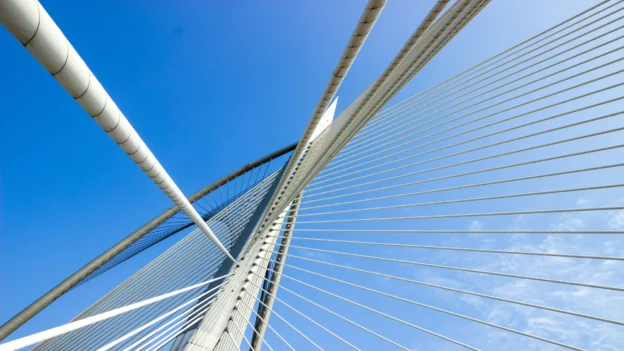A group of researchers have developed a lightweight, intelligent bridge inspection robot capable of climbing bridge cables to perform detailed inspections. Equipped with a machine vision system, the robot has demonstrated a detection accuracy of more than 92% in field tests.
What is this robot looking to solve?
Traditional methods for the inspection of cable-stayed bridges, such as visual assessments by operators or the use of truck cranes, involve high risks for personnel, limited access and low reliability in detecting surface damage. Although the use of drones may offer certain advantages, their inability to inspect cables up close inability to inspect cables up close and in 360 degrees limits their real usefulness in this type of task.
How does the drone work?
The cable climbing robot has a double-wheel traction mechanism, which allows it to adhere frictionally to the cable from below, being able to ascend at speeds of up to 26 meters per minute and adapt to cables with inclinations of between 30º and 90º, and diameters from 70 mm to 270 mm. To achieve this, the researchers used plastic and carbon fiber, achieving a robust but lightweight structure, ideal for easy installation in real conditions.
The drone also carries a module with 4 cameras arranged in a circle to photograph the entire surface of the cable in 360º and a artificial vision system that is in charge of:
- Enhance the images to better see the details.
- Automatically filter out things that are not defects, such as rain marks on the cable or the edges of the protective cover.
- Identify and measure defects once found.
Results in real tests
During field tests on long-span cable-stayed bridges, the robot proved to operate autonomously under conditions such as light rain and wind, adapt to cables from 160 to 235 mm and maintain inspection speeds between 15 and 18 m/min. In fact, in one scenario, it managed to inspect 68 cables in three days, far exceeding the times of manual methods.
The drone analyzed 1892 images and achieved an average accuracy of 92.37% in detecting defects such as scratches, peeling and grooves. The data also identified critical areas, such as the base of the cables near the board, the part where vehicles or pedestrians circulate, and the tower, where defects tend to concentrate.
Limitations and future
Although the system shows great advances in bridge inspection, it sometimes mistakes dirt or grease stains for structural defects. Therefore, the researchers plan to integrate deep learning algorithms so that the robot “learns” to better distinguish between dirt and a serious defect.
This cable-climbing robot represents a significant advance in critical infrastructure maintenance. critical infrastructures that could be used in other areas such as power transmission lines or ship towing and mooring cables.

